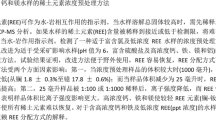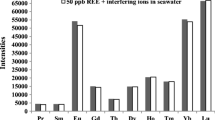Abstract
Rare earth element (REE) patterns in natural water and geological samples provide information on previous changes in environmental conditions, such as redox changes and material cycles; however, quantitative analysis of REEs in these samples is complicated by the relatively low contents of REEs in such samples as well as mass interference from 135Ba16O and 137Ba16O in inductively coupled plasma mass spectrometry (ICP-MS) analyses. In this study, onsite solid-phase extraction and preconcentration methods for REEs using an iminobisacetic acid–ethylenediaminetriacetic acid chelate resin (Nobias Chelate PA1, Hitachi High-Tech Fielding) were adopted for the analyses. Standard reference materials (SPS-SW1 artificial surface water) and natural ground water and spring water samples were used to evaluate the methods. Using the chelate resin, background levels of REEs were found to be less than 0.3 ng L−1 and recovery rates (REEs, 1 ng L−1) were 97.9–106.7% for the artificial surface water. Ba contents were lower than the detection limit after extraction. Additionally, duplicate analyses were performed to check the reproducibility of the onsite extraction. The REE patterns in the natural water samples were in good agreement with those obtained using a previous method (the interference calibration method without solid-phase extraction). Therefore, onsite solid-phase extraction using the chelate resin was demonstrated to be a rapid and simple preparation technique for REE analyses.




Similar content being viewed by others

References
Aosai D, Yamamoto Y, Mizuno T, Ishigami T, Matsuyama H (2014) Size and composition analyses of colloids in deep granitic groundwater using microfiltration/ultrafiltration while maintaining in situ hydrochemical conditions. Colloid Surf A 461:279–286
Arthur RC, Iwatsuki T, Sasao E, Metcalfe R, Amano K, Ota K (2006) Geochemical constraints on the origin and stability of the Tono uranium deposit, Japan. Geochem Explor Environ Anal 6:1–16
Azmy K, Lavoie D, Wang Z, Brand U, Al-Aasm I, Jackson S, Girard I (2013) Magnesium-isotope and REE compositions of Lower Ordovician carbonates from eastern Laurentia: implications for the origin of dolomites and limestones. Chem Geol 356:64–75
Bayon G, Toucanne S, Skonieczny C, Andre L, Bermell S, Cheron S, Dennielou B, Etoubleau J, Freslon N, Gauchery T, Germain Y, Jorry SJ, Meenot G, Monin L, Ponzevera E, Rouget M-L, Tachikawa K, Barrat JA (2015) Rare earth elements and neodymium isotopes in world river sediments revisited. Geochim Cosmochim Acta 170:17–38
Bourdin C, Douville E, Genty D (2011) Alkaline-earth metal and rare-earth element incorporation control by ionic radius and growth rate on a stalagmite from the Chauvet Cave, Southeastern France. Chem Geol 290:1–11
Dobashi R, Shikazono N (2008) Geochemical study of rare earth elements in carbonate minerals in sedimentary rocks around Tono uranium deposit, central Japan—an example of natural analogue study of geological disposal of high-level nuclear waste. Chikyukagaku (Geochemistry) 42:79–98 (in Japanese with English abstract)
Drake H, Tullborg E-L (2009) Paleohydrogeological events recorded by stable isotopes, fluid inclusions and trace elements in fracture minerals in crystalline rock, Simpevarp area, SE Sweden. Appl Geochem 24:715–732
Feng D, Lin Z, Bian Y, Chen D, Peckmann J, Bohrmann G, Roberts HH (2013) Rare earth elements of seep carbonates: indication for redox variations and microbiological processes at modern seep sites. J Asian Earth Sci 65:27–33
Fialho LL, Pereira CD, Nobrega JA (2011) Combination of cool plasma and collision-reaction interface for correction of polyatomic interferences on copper signals in inductively coupled plasma quadrupole mass spectrometry. Spectrochim Acta B 66:389–393
Fisher A, Kara D (2016) Determination of rare earth elements in natural water samples—a review of sample separation, preconcentration and direct methodologies. Anal Chim Acta 935:1–29
Furusho Y, Ono M, Yamada M, Ohashi K, Kitade T, Kiriyama K, Ohta S, Inoue Y, Motomizu S (2008) Advanced solid phase extraction for inorganic analysis and its applications. Bunseki Kagaku 57:969–989 (in Japanese with English abstract)
Iida Y, Kimura Y, Yamaguchi T, Ueda M, Tanaka T, Nakayama S (2009) Sorption distribution coefficients of selenium on a sandy mudstone under reducing conditions of underground. J Nucl Fuel Cycle Environ 15(2):57–67 (in Japanese with English abstract)
Iwatsuki T, Satake H, Metcalfe R, Yoshida H, Hama K (2002) Isotopic and morphological features of fracture calcite from granitic rocks of the Tono area, Japan: a promising palaeohydrogeological tool. Appl Geochem 17:1241–1257
JAEA (2015) 2014 Annual report on METI (Ministry of Economy, Trade and Industry) R&D supporting program for developing geological disposal technology. JAEA, Tokyo (in Japanese)
JAEA (2016) 2015 Annual report on METI (Ministry of Economy, Trade and Industry) R&D supporting program for developing geological disposal technology. JAEA, Tokyo (in Japanese)
Kikawada Y, Fukai M, Oi T (2013) Specific REE patterns observed in sulfurous hot springs from a hydrothermal alteration area in Manza, Japan. Proce Earth Planet Sci 7:428–431
Maskenskaya OM, Drake H, Mathurin FA, Åström ME (2015) The role of carbonate complexes and crystal habit on rare earth element uptake in low-temperature calcite in fractured crystalline rock. Chem Geol 391:100–110
Mizuno T, Iwatsuki T (2006) Long-term stability of geochemical environment at deep underground. Case study of minor elements in carbonate minerals. Chikyukagaku (Geochemistry) 40:33–45 (in Japanese with English abstract)
Munemoto T, Ohmori K, Iwatsuki T (2014) Distribution of U and REE on colloids in granitic groundwater and quality-controlled sampling at the Mizunami Underground Research Laboratory. Prog Earth Planet Sci 1:28
Munemoto T, Ohmori K, Iwatsuki T (2015) Rare earth elements (REE) in deep groundwater from granite and fracture-filling calcite in the Tono area, central Japan: prediction of REE fractionation in paleo- to present-day groundwater. Chem Geol 417:58–67
Och LM, Müller B, Wichser A, Ulrich A, Vologina EG, Sturm M (2014) Rare earth elements in the sediments of Lake Baikal. Chem Geol 376:61–75
Ogawa Y, Yamasaki S, Tsuchiya N (2010) Application of a dynamic reaction cell (DRC) ICP-MS in chromium and iron determination in rock, soil and terrestrial water samples. Anal Sci 26:867–872
Saitoh Y, Iijima A, Kimura S, Kozawa K (2013) Preliminary study on evaluation of rare earth elements in hot spring water as a geochemical indicator intended to understand hot spring water flow. J Hot Spring Sci 63:141–157 (in Japanese with English abstract)
Sakamoto H, Yamamoto K, Shirasaki T, Inoue Y (2006) Pretreatment method for determination of trace elements in seawater using solid phase extraction column packed with polyamino-polycarboxylic acid type chelating resin. Bunseki Kagaku 55:133–139 (in Japanese with English abstract)
Sanada T, Nagashima H, Matsumoto G-I (2013) Geochemical features and formation mechanism of chemical components in the Goshikinuma water system of Urabandai, Fukushima prefecture in Japan. J Hot Spring Sci 63:13–27 (in Japanese with English abstract)
Sandström B, Tullborg E-L, Larson SA, Page L (2009) Brittle tectonothermal evolution in the Forsmark area, central Fennoscandian Shield, recorded by paragenesis, orientation and 40Ar/39Ar geochronology of fracture minerals. Tectonophysics 478:158–174
Siebert C, Pett-Ridge JC, Opfergelt S, Guicharnaud RA, Halliday AN, Burton KW (2015) Molybdenum isotope fractionation in soils: influence of redox conditions, organic matter, and atmospheric inputs. Geochim Cosmochim Acta 162:1–24
Sohrin Y, Urushihara S, Nakatsuka S, Kono T, Higo E, Minami T, Norisuye K, Umetani S (2008) Multielemental determination of GEOTRACES key trace metals in seawater by ICPMS after preconcentration using an ethylenediaminetriacetic acid chelating resin. Anal Chem 80:6267–6273
Tsuneto A, Suzuki Y, Furusho Y, Furuta N (2009) Development of the determination method of rare earth elements in seawater by ICP-MS with an on-line preconcentration column of improved iminodiacetate resin and its application to Tokyo Bay seawater. Bunseki Kagaku 58:623–631 (in Japanese with English abstract)
Watanabe T, Tsuchiya N, Yamasaki S, Yamada R, Hirano N, Okamoto A, Nara FW, Tohoku Tsunami Sediment Research Group (2014) Seawater-leaching testing for arsenic and heavy metals in tsunami deposits produced by the 2011 off the Pacific coast of Tohoku earthquake, northeastern Japan. Chigaku Zasshi 123:835–853 (in Japanese with English abstract)
Wood SA, van Middlesworth P, Gibson P, Ricketts A (1997) The mobility of the REE, U and Th in geological environments in Idaho and their relevance to radioactive waste disposal. J Alloys Compounds 249:136–141
Wyndham T, Mcculloch M, Fallon S, Alibert C (2004) High-resolution coral records of rare earth elements in coastal seawater: biogeochemical cycling and a new environmental proxy. Geochim Cosmochim Acta 68:2067–2080
Yamamoto K, Sakamoto H, Yonetani A, Shirasaki T (2007) Determination of trace metals in salt and sea water by means of ICP-AES and MIP-MS with preconcentration using the polyamino-polycarboxylic acid type chelating resin solid phase extraction. Bull Soc Sea Water Sci 61:260–267 (in Japanese)
Yamazaki, M, Kato, S, Tsukada, S, Yoshioka, O (2009) Analysis of trace metal elements in environmental waters by solid-phase extraction using iminobisacetic acid–ethylenediaminetriacetic acid chelating resin. Annu Rep Mie Prefect Health Environ Res Inst 11:108–116 (in Japanese)
Zhu Y, Itoh A, Umemura T, Haraguchi H, Inagaki K, Chiba K (2010) Determination of REEs in natural water by ICP-MS with the aid of an automatic column changing system. J Anal At Spectrom 25:1253–1258
Acknowledgements
This work was partly supported by a METI (Ministry of Economy, Trade and Industry of Japan) program for the research and development of technology relating to geological disposal. The authors express their gratitude to the Chubu branch office of the Hitachi High-Tech Fielding Corporation. N. Takamura, Y. Shorin, and an anonymous reviewer are acknowledged for their helpful comments and suggestions for improving the manuscript.
Author information
Authors and Affiliations
Corresponding author
Additional information
Handling Editor: Yoshiki Sohrin.
Rights and permissions
About this article
Cite this article
Watanabe, T., Saito-Kokubu, Y., Murakami, H. et al. Onsite chelate resin solid-phase extraction of rare earth elements in natural water samples: its implication for studying past redox changes by inorganic geochemistry. Limnology 19, 21–30 (2018). https://doi.org/10.1007/s10201-017-0513-3
Received:
Accepted:
Published:
Issue Date:
DOI: https://doi.org/10.1007/s10201-017-0513-3



